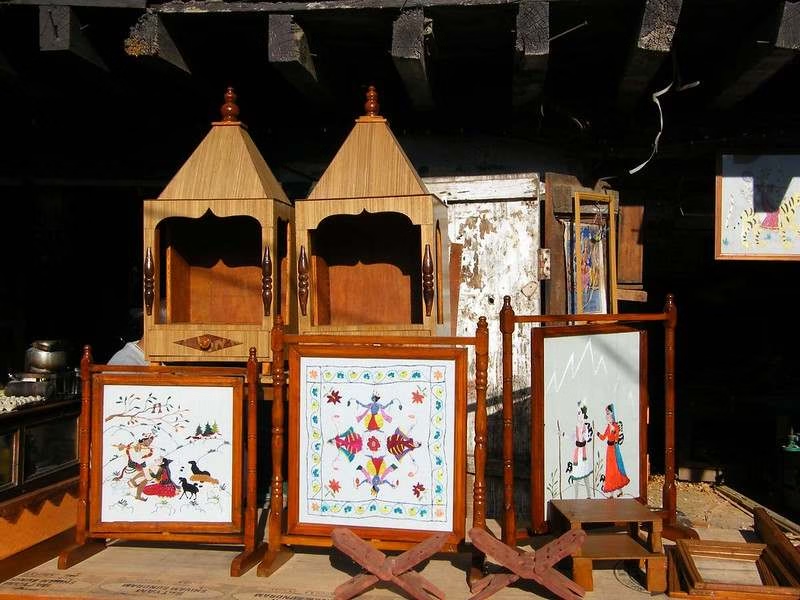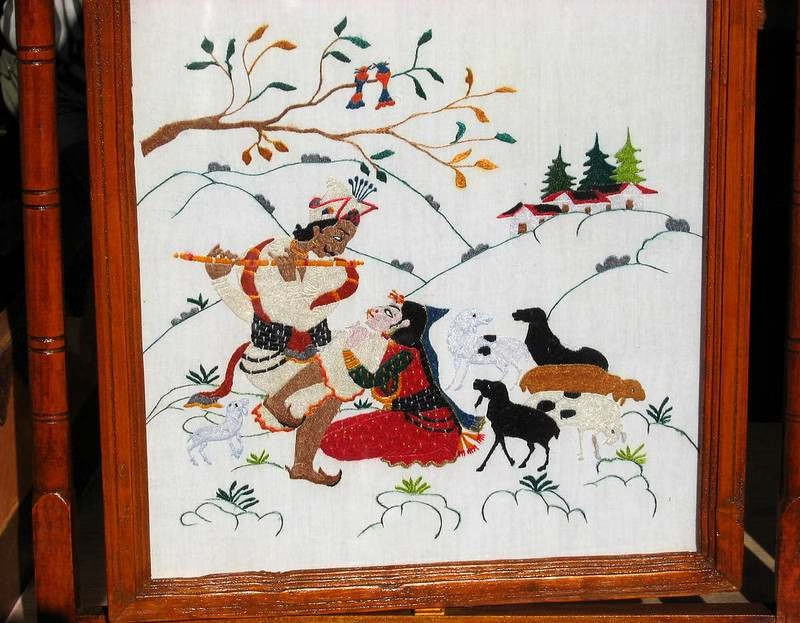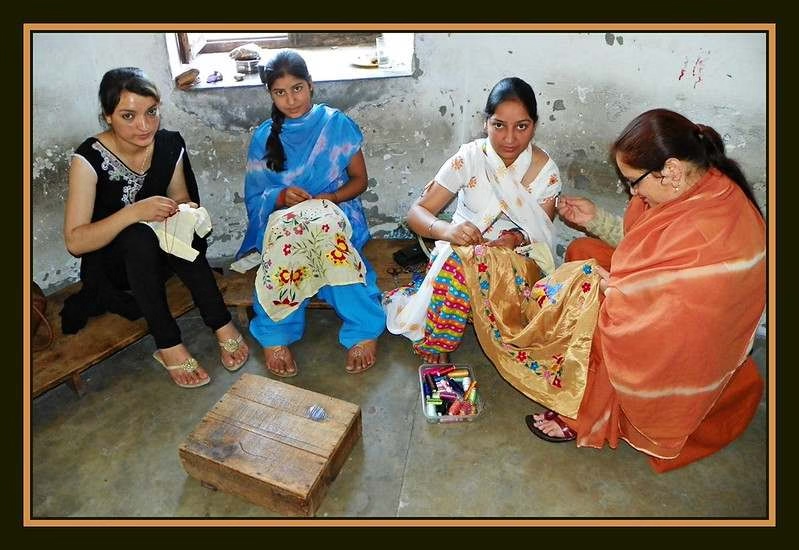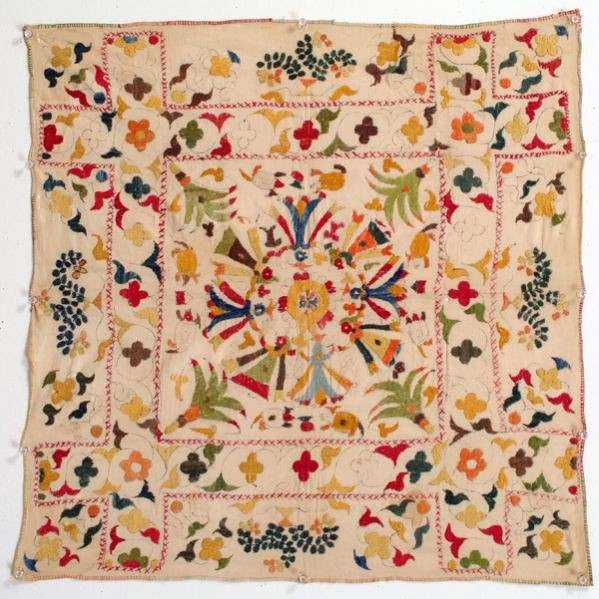Hey folks! Welcome to another piece of real folk art stories! Step into the colorfully vibrant world of Chamba Rumal embroidery, where each stitch speaks louder than words can!
Located deep in the stunning valleys of Himachal Pradesh, this beautifully exquisite form of Himachal embroidery has silently narrated love, devotion, and tradition from the centuries it has existed. Imagine some soft fabric-turned-canvas full of intricate threadwork depicting themes from mythology and nature to regular life. That’s the magic of Chamba Rumal—a treasure of traditional Indian crafts that’s as old as it’s beautiful.
Did you know? These dainty hand-embroidered rumals or handkerchiefs were once exchanged as precious gifts among royalty and nobility. Today, they are celebrated worldwide for their artistry, with some pieces taking months, even years, to complete! From the delicate do-rukha (double-sided) technique to the vibrant colors inspired by the Himalayas, every detail is a testament to the skill of Himachal’s artisans.
Ready to dive deeper into the enchanting world of Chamba Rumal embroidery? Let’s unravel the threads of history, culture, and creativity together!
What Are Chamba Rumals? Stitching Stories from the Himalayas!
Picture this: a square of cloth so intricately embroidered it feels like holding a miniature painting stitched with love. Welcome to the world of Chamba Rumals—a dazzling Himachal embroidery tradition that turns humble fabric into storytelling magic!
Originating from the misty hills of Himachal Pradesh, these rumals (handkerchiefs) are more than just textiles; they are heirlooms of culture, patience, and creativity.
Unraveling the Origins: Where Did Chamba Rumals Begin?
History with a Royal Twist!

The Chamba Rumal embroidery dates back to the 17th century, flourishing under the patronage of Chamba’s royal family. The history of Chamba Rumal dates back to the late 16th and early 17th centuries. During the reign of Raja Umed Singh (1748-1764 A.D.), Chamba Rumal gained prominence. Inspired by
Pahari miniature paintings, this craft blended local motifs with influences from Mughal art, thanks to cultural exchanges along trade routes.
- Myth Meets Thread: Legend says queens and noblewomen initially embroidered these rumals as ceremonial gifts for weddings and religious rituals.
- Global Recognition: In 2021, Chamba Rumal received the Geographical Indication (GI) tag, cementing its status as a cultural gem.
The Artistry: What Makes Chamba Rumal Embroidery Unique?
It’s All in the Details!
Unlike ordinary embroidery, Chamba Rumals uses the do-rukha (double-sided) technique, where designs mirror perfectly on both sides of the fabric—no loose threads, no compromises!
Popular Themes & Types:
- Religious Narratives: Scenes from Hindu epics like Krishna-Leela or Ramayana.
- Folk Tales & Festivals: Celebrations like Minjar Mela or love stories from local legends.
- Nature’s Bounty: Flowers, animals, and geometric patterns inspired by Himalayan landscapes.
Materials Used:
- Fabric: Traditionally, muslin or silk.
- Threads: Untwisted silk (pattu) or cotton dyed with natural colors like indigo and pomegranate.
From Thread to Treasure: How Are Chamba Rumals Made?
A Dance of Patience & Precision
Creating a Chamba Rumal isn’t a weekend project—it’s a 3-12 month marathon! Here’s how artisans work their magic:
- Design Transfer: Artists first sketch intricate patterns onto the fabric using charcoal or ink.
- Stitch by Stitch: Using dorukha tamba (double satin stitch), they fill the outlines with vibrant threads, ensuring both sides look identical.
- Finishing Touches: Borders are adorned with floral motifs, and the rumal is washed to enhance its luster.
Pro Tip: A single rumal can feature over 10,000 stitches—talk about dedication!
Market Value: What’s a Chamba Rumal Worth Today?
From Royal Courts to Global Markets
Once reserved for kings, Chamba Rumals now enchant collectors worldwide. Their value? It’s as rich as their history!
- Price Range: Small pieces (12×12 inches) start at ₹5,000, while elaborate works can cost ₹50,000+.
- Global Appeal: Sold in luxury stores from Delhi to New York, they’re prized for their rarity and craftsmanship.
- Challenges: Only 200-300 artisans practice this craft today, making each piece a limited-edition masterpiece.
Fun Fact: In 2019, a vintage Chamba Rumal sold at a Delhi auction for ₹1.2 lakh!
Why Chamba Rumals Matter: Keeping the Craft Alive
More Than Just Embroidery—It’s Heritage!
While machine-made imitations flood markets, true Chamba Rumal embroidery thrives due to:
- Government Initiatives: Schemes like Himachal Hastshilp provide training and market access.
- Cultural Pride: Young artisans are reviving the craft, blending traditional motifs with modern designs (think rumal-inspired coasters or wall hangings!).
Your Role: Buying authentic Chamba Rumals supports artisans and keeps this traditional Indian craft alive for future generations.
Artistic Techniques of Chamba Rumal: The Unique Double-Sided Embroidery

Step into the enchanting world of Chamba Rumal embroidery, where every stitch is a masterpiece and every thread tells a story. This Himachal embroidery tradition is not just about beauty—it’s about precision, skill, and a technique so unique it leaves art lovers spellbound.
The double-sided embroidery of Chamba Rumals is what sets it apart, making it a treasure of traditional Indian crafts. Let’s dive deep into the artistic techniques that make Chamba Rumals a timeless wonder!
The Do-Rukha Technique: Double-Sided Magic
What Makes It Unique?
The hallmark of Chamba Rumal embroidery is the do-rukha (double-sided) technique, where the design appears identical on both sides of the fabric. No loose threads, no messy backs—just flawless artistry!
- Mirror-Like Precision: Both sides of the rumal look exactly the same, a feat achieved through meticulous stitching.
- No Knots, No Ends: Artisans hide thread ends within the stitches, ensuring a clean finish.
- Time-Intensive Craft: A single rumal can take 3 to 12 months to complete, depending on its size and complexity.
Fun Fact: Only a handful of artisans in Himachal Pradesh master this technique today, making each rumal a rare gem.
Stitches That Speak: The Art of Satin Stitch
The Heart of Chamba Rumal Embroidery
The satin stitch is the backbone of this craft, filling motifs with smooth, glossy threads that resemble painted strokes.
- How It Works: Artisans use untwisted silk or cotton threads to create flat, even stitches that cover the fabric completely.
- Perfect Alignment: Stitches are placed so close together that the fabric underneath becomes invisible.
- Vibrant Colors: Threads are dyed in natural hues like indigo, pomegranate, and turmeric, giving the rumals their signature brilliance.
Pro Tip: The satin stitch is so precise that a single square inch can contain hundreds of stitches!
Design Transfer: From Paper to Fabric
The First Step to Perfection
Before the embroidery begins, artisans transfer intricate designs onto the fabric, a process that requires both skill and patience.
- Sketching the Design: Artists draw detailed patterns inspired by Pahari miniature paintings, mythology, or nature.
- Tracing onto Fabric: The design is traced onto the fabric using charcoal or ink, ensuring every line is accurate.
- Color Planning: Artisans decide the color palette, keeping in mind the balance and harmony of the final piece.
Did You Know?: Some designs feature over 50 colors, each carefully chosen to bring the motifs to life.
Motifs That Tell Stories: Themes in Chamba Rumal Embroidery

A Visual Feast of Culture and Tradition
The motifs in Chamba Rumals are not just decorative—they’re narrative. Each design carries a story, a belief, or a piece of Himachal’s rich heritage.
- Mythological Tales: Scenes from Hindu epics like the Ramayana and Mahabharata or Krishna’s playful Raas-Leela.
- Nature’s Beauty: Flowers, birds, and animals inspired by the lush Himalayan landscapes.
- Daily Life: Depictions of festivals, dances, and rural activities, capturing the essence of Himachali culture.
Popular Motifs:
- Tree of Life: Symbolizing growth and prosperity.
- Floral Patterns: Representing beauty and harmony.
- Geometric Borders: Adding symmetry and elegance to the rumal.
The Making Process: Step-by-Step Artistry
From Thread to Treasure
Creating a Chamba Rumal is a labor of love involving multiple stages of meticulous work. Here’s how it’s done:
- Fabric Selection: Traditionally, artisans use muslin or silk for their smooth texture and durability.
- Design Transfer: The chosen design is traced onto the fabric using charcoal or ink.
- Embroidery Begins: Using the do-rukha technique, artisans fill the design with satin stitches, ensuring both sides look identical.
- Bordering: The edges are adorned with floral or geometric patterns, framing the central design beautifully.
- Finishing Touches: The rumal is washed and pressed to enhance its luster and softness.
Stat Alert: A medium-sized Chamba Rumal can feature over 10,000 stitches, each placed with precision!
Challenges and Revival: Keeping the Craft Alive
A Craft Worth Preserving
While Chamba Rumal embroidery is celebrated globally, it faces challenges that threaten its survival.
- Declining Artisans: Only 200-300 artisans practice this craft today, many of whom are aging.
- Time-Consuming Process: The intricate work often deters younger generations from learning the craft.
- Market Competition: Machine-made imitations flood the market, undercutting the value of handmade rumals.
Revival Efforts:
- Government Initiatives: Schemes like Himachal Hastshilp provide training and financial support to artisans.
- Workshops and Exhibitions: Organizations conduct workshops to teach the craft to younger generations.
- Global Recognition: The Geographical Indication (GI) tag awarded in 2021 has boosted the rumal’s prestige and market value.
Did You Know?: A single Chamba Rumal can sell for ₹5,000 to ₹50,000, depending on its size and intricacy.
Why Chamba Rumal Embroidery Matters
More Than Just Art—It’s Heritage
Chamba Rumals are not just textiles; they’re a bridge between the past and the present. Each rumal carries the legacy of Himachal’s artisans, their stories, and their unwavering dedication to preserving a traditional Indian craft.
- Cultural Pride: They symbolize the rich artistic heritage of Himachal Pradesh.
- Sustainable Craft: Made with natural materials and dyes, they’re eco-friendly and timeless.
- Artistic Excellence: The double-sided embroidery is a testament to human skill and creativity.
Modern Revival: Sustaining the Legacy of Himachal Embroidery

The delicate threads of Chamba Rumal embroidery have woven stories for centuries, but in today’s fast-paced world, this traditional Indian craft faces the risk of fading into obscurity. Thankfully, a wave of modern revival efforts is breathing new life into this exquisite Himachal embroidery, ensuring its legacy continues to thrive. From government initiatives to innovative designs, let’s explore how the timeless art of Chamba Rumal fabric is being preserved and reimagined for the future.
The Challenge: Why Chamba Rumal Embroidery Needs Revival
A Craft at Risk
Despite its rich history and cultural significance, Chamba Rumal embroidery has faced numerous challenges in recent decades.
- Declining Artisans: Only 200-300 artisans practice this craft today, many of whom are aging.
- Time-Intensive Process: Creating a single rumal can take 3 to 12 months, making it less appealing to younger generations.
- Market Competition: Machine-made imitations and cheaper alternatives have flooded the market, reducing demand for handmade pieces.
- Lack of Awareness: Many people are unaware of the artistry and effort behind Chamba Rumal fabric, leading to undervaluation.
Stat Alert: In the 1980s, there were over 1,000 artisans practicing this craft. Today, the number has dwindled to just a few hundred.
Government Initiatives: A Lifeline for Himachal Embroidery
Policy Support to Preserve Tradition
Recognizing the cultural importance of Chamba Rumal embroidery, the government and NGOs have launched several initiatives to support artisans and promote the craft.
- Geographical Indication (GI) Tag: Awarded in 2021, the GI tag has elevated the status of Chamba Rumals, ensuring their authenticity and protecting them from imitation.
- Financial Assistance: Schemes like Himachal Hastshilp provide artisans with financial aid, tools, and raw materials.
- Training Programs: Workshops and skill development programs are organized to train younger generations in this traditional Indian craft.
Impact: These initiatives have helped increase the income of artisans by 20-30%, encouraging more people to take up the craft.
Innovative Designs: Blending Tradition with Modernity
From Heirlooms to Home Décor
To appeal to contemporary audiences, artisans and designers are reimagining Chamba Rumal fabric in innovative ways.
- New Products: Beyond traditional handkerchiefs, Chamba Rumal motifs now adorn cushion covers, wall hangings, sarees, and even handbags.
- Fusion Designs: Combining traditional embroidery with modern silhouettes, such as incorporating rumal patterns into Western wear.
- Customization: Offering personalized designs for weddings, festivals, and corporate gifting.
Success Story: In 2022, a designer collaboration featuring Chamba Rumal-inspired apparel saw a 40% increase in sales, proving the craft’s modern appeal.
Artisan Cooperatives: Strength in Unity
Empowering Communities Through Collaboration
Artisan cooperatives have played a crucial role in reviving Himachal embroidery by providing a platform for artisans to work together and access larger markets.
- Collective Marketing: Cooperatives help artisans sell their products directly to buyers, eliminating middlemen and ensuring fair prices.
- Skill Sharing: Experienced artisans mentor newcomers, preserving the craft’s techniques and traditions.
- Exhibitions and Fairs: Cooperatives organize events to showcase Chamba Rumals, attracting buyers and raising awareness.
Stat Alert: Artisans working through cooperatives report a 25% higher income compared to those working independently.
Digital Platforms: Taking Chamba Rumal Embroidery Global
From Local Markets to Online Stores
The internet has become a powerful tool for promoting Chamba Rumal fabric and connecting artisans with global audiences.
- E-Commerce Platforms: Websites like Amazon, Etsy, and dedicated craft portals sell Chamba Rumals worldwide.
- Social Media: Instagram and Facebook showcase the beauty of Himachal embroidery, attracting younger buyers.
- Virtual Workshops: Online classes teach enthusiasts the basics of Chamba Rumal embroidery, spreading awareness and interest.
Did You Know?: Online sales of Chamba Rumals have grown by 35% in the last two years, reaching buyers in the US, Europe, and Australia.
Celebrity Endorsements and Media Coverage
Shining a Spotlight on Himachal Embroidery
Celebrities and media have played a significant role in bringing Chamba Rumal fabric into the limelight.
- Celebrity Support: Bollywood stars and fashion icons have been spotted wearing Chamba Rumal-inspired outfits, boosting its popularity.
- Documentaries and Features: TV shows and magazines highlight the craft’s beauty and the artisans’ stories, creating awareness.
- Awards and Recognition: Artisans have received national and international awards, celebrating their skill and dedication.
Fun Fact: A Chamba Rumal-inspired outfit worn by a Bollywood actress at an international event went viral, increasing online searches for the craft by 50%.
The Bottom Lines
Chamba Rumal embroidery is the most beautiful example of tradition mixed with innovation. This traditional Indian craft, originating from the royal times of Himachal Pradesh and revived now, has withstood the test of time with the dedication of artisans and the support of initiatives to preserve its legacy.
Chamba Rumal fabric blends age-old techniques with modern designs and has managed to find its space in contemporary homes and wardrobes without being detached from the rich cultural past.
We can not forget that with every piece of Himachal embroidery we buy, we are promoting the craft and the artisans. While a hand-embroidered rumal with traditional embroidery is a treasure in itself, it is the modern adaptations that make the same rag woven with the soul of the Himalayas. Let’s cherish this artistic treasure by weaving threads for generations to come! ????
Let’s explore, support, and celebrate because every stitch matters!
For further reading, you can visit these useful resources:
Check out our Blog Page on Traditional Indian art.


Leave a Reply